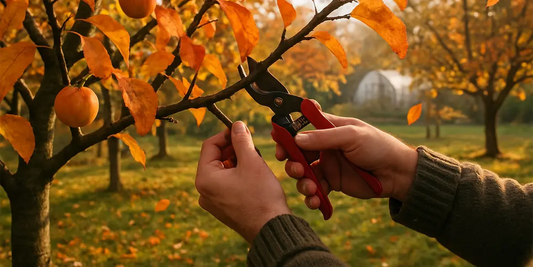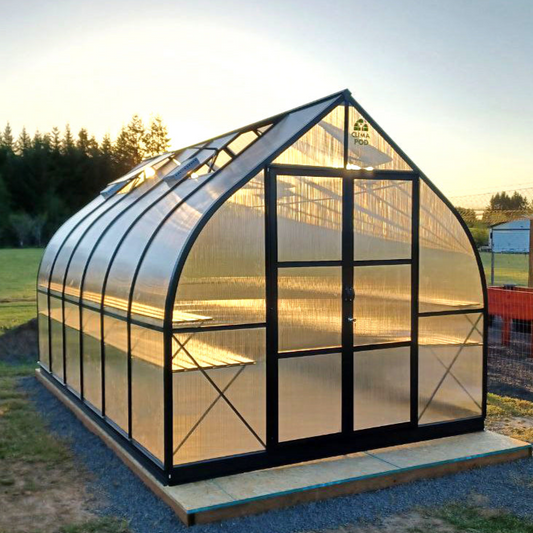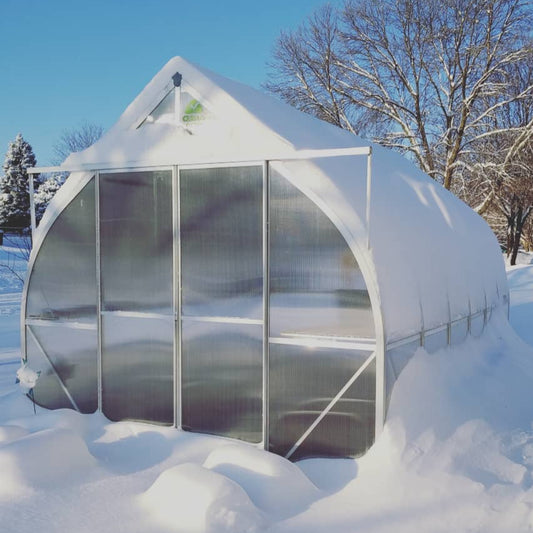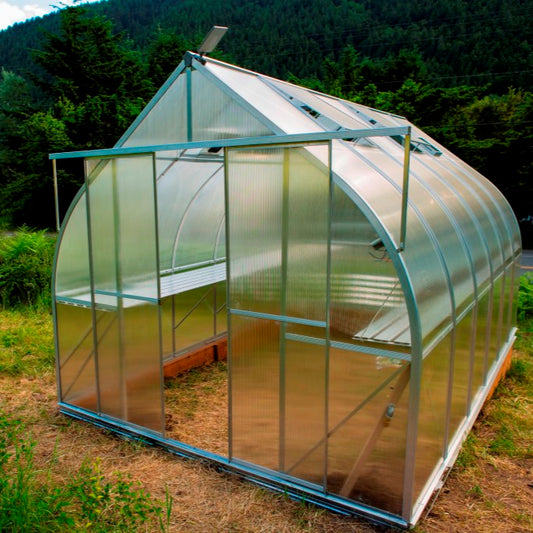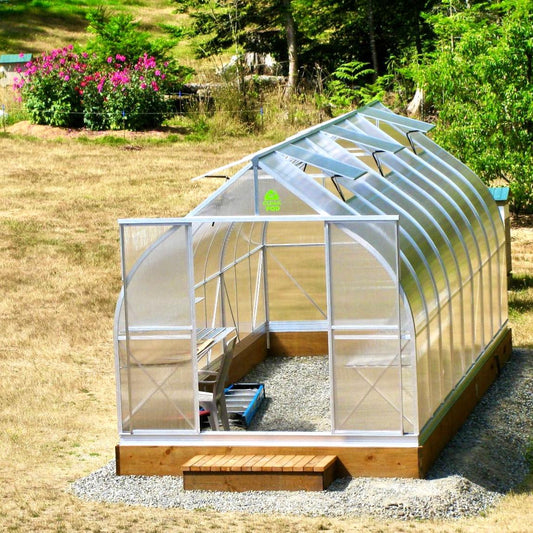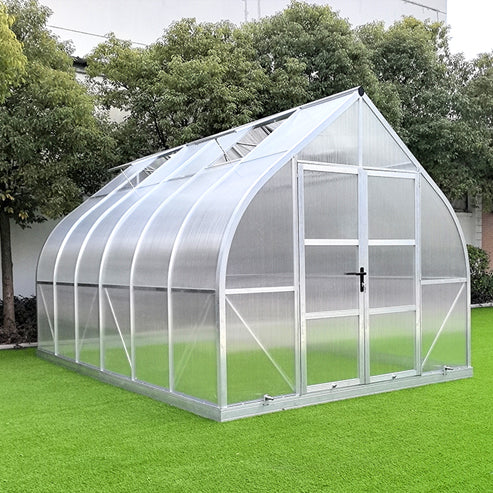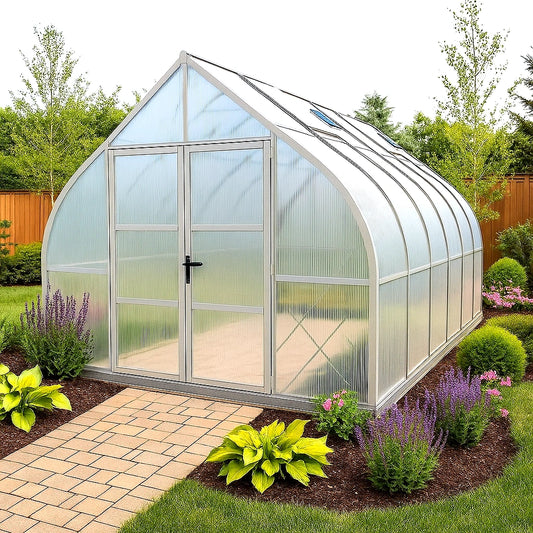
Healthy Plants: How to Ventilate Your Greenhouse
Why Ventilation in a Polycarbonate Greenhouse Is Essential
Polycarbonate greenhouses are excellent at capturing and retaining heat, creating an ideal environment for plant growth even in cooler months. But without proper ventilation, that same heat can turn your greenhouse into a sauna, damaging crops and encouraging disease.
Let’s break down the difference between healthy airflow and harmful drafts, and how to set up proper ventilation to protect your plants year-round.
What Happens Without Ventilation?
Without fresh air, greenhouse conditions can quickly become unstable. Here's what can go wrong:
- Overheating on hot days can scorch plants, halt growth, or kill seedlings.
- Stale, humid air creates a perfect breeding ground for mold, mildew, and fungal infections.
- Poor airflow makes pest control more difficult and weakens plants' natural defenses.
Effective ventilation prevents these problems by:
- Regulating temperature and reducing heat buildup
- Controlling humidity levels
- Providing CO₂-rich fresh air for stronger, faster growth
- Improving pollination in flowering crops
- Preventing disease and insect infestations
Ventilation vs. Drafts: What’s the Difference?
While both involve moving air, ventilation and drafts are very different in effect:
- Ventilation is a controlled process, typically using roof vents, side vents, or fans to gently circulate air. It creates a stable microclimate that supports plant health.
- A draft is an uncontrolled burst of air, usually caused by opening doors or windows on opposite ends of the greenhouse. It creates a sudden rush that disrupts humidity, temperature, and airflow balance.
Why Drafts Are Dangerous for Plants
While ventilation is critical for your greenhouse, drafts can be harmful, especially in polycarbonate structures. Here’s why:
- Drafts cause rapid drops in temperature, which can stress or even shock plants.
- They dry out the surrounding air, accelerating moisture loss from leaves and soil.
- Sensitive plants may wilt or droop due to sudden changes in evaporation rate.
- Even cold-tolerant crops can suffer thermal stress or “greenhouse chill” if airflow exceeds 1 meter per second (~2.2 mph).
Tip: You may not feel the damage right away, but over time, repeated drafts can stunt growth and reduce yields.

How to Create Smart Balanced Ventilation
- Use roof vents or side vents to release warm air naturally. Warm air rises, let it out from the top.
- Install an automatic window opener to maintain consistent airflow without manual adjustment.
- Add a solar-powered thermostatic fan (like ClimaPod’s model) to circulate air when temps rise.
- Always install an intake vent on the opposite wall from your exhaust vent or fan for steady cross-flow without creating a direct path for wind.
- In winter, use adjustable vents or closeable louvers to retain heat while still allowing some air movement.
Bonus: ClimaPod Solar Powered Thermostatic Fan

Our Solar Powered Thermostatic Fan makes greenhouse ventilation effortless. It automatically turns on when temperatures rise, no wiring or electricity needed. Perfect for off-grid gardeners or anyone looking to lower their energy use.
Key Benefits:
- Eco-friendly & fully solar-powered
- Automatically responds to temperature changes
- Easy installation on most polycarbonate greenhouses
- Prevents overheating without manual effort
With ClimaPod’s ventilation solutions, you don’t just grow, you thrive.
How to Ventilate a Polycarbonate Greenhouse Without Stressing Your Plants
Not all crops like the same air. In fact, some greenhouse favorites like cucumbers and peppers are surprisingly sensitive to drafts, while others, like tomatoes, actually thrive with a gentle breeze. Understanding these preferences is key to healthy growth and high yields in your polycarbonate greenhouse.
Let’s look at how different plants respond to air movement and how to ventilate your greenhouse the right way, without causing stress or disrupting the microclimate.
How Plants React to Drafts
Cucumbers, for example, love warmth and moisture. They can tolerate stagnant air surprisingly well but suffer in even mild drafts. For them, ventilation should be subtle, just enough to prevent disease, usually through roof or door vents that gently refresh the air without sudden gusts.
Peppers and eggplants are similar. They don't mind a temporary dip in temperature or even slightly stuffy conditions, but they’re very sensitive to sudden airflow. Sharp drafts can stunt growth or trigger stress responses, so it’s best to ventilate through upper vents, allowing warm air to escape without pushing a cold stream across the plants.
Tomatoes, on the other hand, are the outliers. These crops prefer cooler, well-ventilated conditions. Still air can lead to disease, particularly late blight, and pollination fails without a light breeze. In hot weather, it’s actually beneficial to leave the greenhouse doors wide open, just make sure airflow is steady, not forceful.
When to Ventilate: Timing Is Everything
Ventilating at the right time of day makes a big difference. The heat inside a polycarbonate greenhouse builds up quickly, especially from late morning to early afternoon. This is the ideal window roughly from 11 a.m. to 3 p.m. to vent warm air and prevent overheating.
On sunny mornings, it's best to ventilate shortly after sunrise. This helps reduce condensation buildup, which is a major cause of fungal disease. On cloudy or cooler days, ventilation should still happen, just more gently and for shorter durations. If outdoor temps drop to around 50°F, keep vents open no longer than two hours.
Avoid ventilating after sunset. Once the sun goes down, the greenhouse cools rapidly, and any extra airflow could cause unnecessary heat loss.
Contrary to some concerns, plants do not “catch cold” from fresh air, but condensation from covers or dropcloths can damage leaves, so it’s better to keep plants uncovered during regular venting.
Does Greenhouse Size Matter?
Absolutely. Smaller greenhouses are simpler to manage. Roof or end-wall vents are usually enough to maintain airflow. But larger structures, especially those over 25 feet long or 9 feet wide, need more thought.
Air struggles to move in long or wide greenhouses, especially if the interior is packed with crops. In those cases, passive airflow isn’t enough. Sidewall vents, ideally at staggered heights, help move warm air out and bring cool air in evenly. You should also consider leaving walking lanes free of plants, these serve as natural air channels.
For backyard growers, a greenhouse around 21 feet long and 7–9 feet wide, like the ClimaPod Virtue 9×28 model, offers a practical balance. It's easy to ventilate, naturally retains warmth, and provides enough space for smart airflow planning.
What If You Can’t Be There to Open the Vents?

Most hobby growers don’t have time to monitor vents all day. That’s where automatic window openers come in. These low-maintenance devices use a heat-sensitive piston to open and close vents based on inside temperature. No power source needed. Once installed, they quietly take care of temperature control for you, day and night.
If you're managing a larger or high-performance greenhouse, consider pairing these openers with a solar-powered thermostatic fan. It activates automatically when heat builds up, circulates air evenly, and works completely off the grid.
ClimaPod Makes Ventilation Easy and Efficient
Whether you're growing tomatoes in Texas or cucumbers in Colorado, ventilation is a key part of healthy greenhouse growing. With ClimaPod’s ventilation systems (auto window openers and solar-powered thermostatic fans) you don’t have to compromise between automation and sustainability.
Looking to upgrade your greenhouse ventilation? Our team can help you choose the right setup for your layout, climate, and crops.



